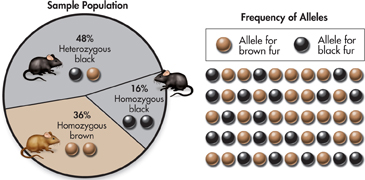How does that work? In any population, some individuals have phenotypes that are better suited to their environment than are the phenotypes of other individuals. The better-suited individuals produce more offspring than the less fit individuals do. Therefore, organisms with higher fitness pass more copies of their genes to the next generation.
Natural selection never acts directly on genes. Why? Because it is an entire organism—not a single gene—that either survives and reproduces or dies without reproducing.
 In Your Notebook Describe how natural selection affects genotypes by acting on phenotypes.
In Your Notebook Describe how natural selection affects genotypes by acting on phenotypes.

FIGURE 17–2 Alleles in a Population When scientists try to determine whether a population is evolving, they study its allele frequencies. This diagram shows allele frequencies for fur color in a mouse population. Calculate Here, in a total of 50 alleles, 20 alleles are B (black) and 30 are b (brown). How many of each allele would be present in a total of 100 alleles? 
Populations and Gene Pools Genetic variation and evolution are both studied in populations. A population is a group of individuals of the same species that mate and produce offspring. Because members of a population interbreed, they share a common group of genes called a gene pool. A gene pool consists of all the genes, including all the different alleles for each gene, that are present in a population.
Researchers study gene pools by examining the numbers of different alleles they contain. Allele frequency is the number of times an allele occurs in a gene pool, compared to the total number of alleles in that pool for the same gene. For example, in the mouse population in Figure 17–2, the allele frequency of the domiant B allele (black fur) is 40 percent, and the allele frequency of the recessive b allele (brown fur) is 60 percent. The allele frequency of an allele has nothing to do with whether the allele is dominant or recessive. In this mouse population, the recessive allele occurs more frequently than the dominant allele.
BUILD Vocabulary
MULTIPLE MEANINGS Perhaps the most common definition of the noun pool is a large man-made body of water in which you can swim. However, a pool can also refer to an available supply of a resource. In the case of a gene pool, the resource is genetic information.
 Evolution, in genetic terms, involves a change in the frequency of alleles in a population over time. For example, if the frequency of the B allele in Figure 17–2 drops to 30 percent, the population is evolving. It's important to note that populations, not individuals, evolve. Natural selection operates on individual organisms, but the changes it causes in allele frequency show up in the population as a whole.
Evolution, in genetic terms, involves a change in the frequency of alleles in a population over time. For example, if the frequency of the B allele in Figure 17–2 drops to 30 percent, the population is evolving. It's important to note that populations, not individuals, evolve. Natural selection operates on individual organisms, but the changes it causes in allele frequency show up in the population as a whole.

Table of Contents
- Formulas and Equations
- Applying Formulas and Equations
- Mean, Median, and Mode
- Estimation
- Using Measurements in Calculations
- Effects of Measurement Errors
- Accuracy
- Precision
- Comparing Accuracy and Precision
- Significant Figures
- Calculating With Significant Figures
- Scientific Notation
- Calculating With Scientific Notation
- Dimensional Analysis
- Applying Dimensional Analysis




